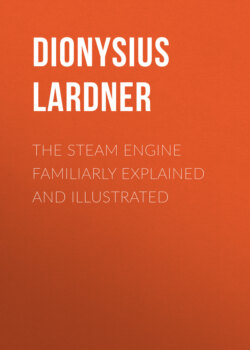Читать книгу The Steam Engine Familiarly Explained and Illustrated - Dionysius Lardner - Страница 8
SOLOMON DE CAUS, 1615.
ОглавлениеFig.2.
(25.) A work entitled "Les Raisons des Forces Mouvantes, avec diverses Machines tant utiles que plaisantes," published at Frankfort in 1615, by Solomon de Caus, a native of France, contains the following theorem:—
"Water will mount by the help of fire higher than its level," which is explained and proved in the following terms:—
"The third method of raising water is by the aid of fire. On this principle may be constructed various machines: I shall here describe one. Let a ball of copper marked A, well soldered in every part, to which is attached a tube and stopcock marked D, by which water may be introduced; and also another tube marked B C, which will be soldered into the top of the ball, and the lower end C of which shall descend nearly to the bottom of the ball without touching it. Let the said ball be filled with water through the tube D, then shutting the stopcock D, and opening the stopcock in the vertical tube B C, let the ball be placed upon a fire, the heat acting upon the said ball will cause the water to rise in the tube B C."
Such is the description of the apparatus of De Caus as given by himself; and on this has been founded a claim to the invention of the steam engine. It will be observed, that neither in the original theorem nor in the description of the machine which accompanies it, is the word steam anywhere used. Now it was well known, by all conversant in physics, long before the date of the publication containing this description, that atmospheric air when heated acquires an increased elastic force. As the experiment is described, the other part of the ball A is filled with atmospheric air; the heat of the fire acting upon the air through the external surface of the ball, and likewise transmitted through the water, would of course raise the temperature of the air contained in the vessel, would thereby increase its elasticity, and would cause the water to rise in the tube B C, upon a physical principle altogether independent of the qualities of steam. The effect produced, therefore, is just what might have been expected by any one acquainted with the common properties of air, though entirely ignorant of those of steam; and, in point of fact, the pressure of the air is as much concerned in this case in raising the water as the pressure of the steam.
This objection, however, is combated by another theorem contained in the same work, in which De Caus speaks of "the strength of the vapour produced by the action of the fire, which causes water to mount; which vapour will issue from the stopcock with great violence after the water has been expelled."
If De Caus be admitted to have understood the elastic property of the vapour of water, and to have attributed the ascent of the water in the tube C B to the pressure of that vapour upon the surface of the water confined in the copper ball, it must be admitted that he suggested one of the ways of using the power of steam as a mechanical agent. In the modern steam engine this pressure is not now used against a liquid surface, but against the solid surface of a piston. This, however, should not take from De Caus whatever credit be due to the suggestion of the physical property in question.
